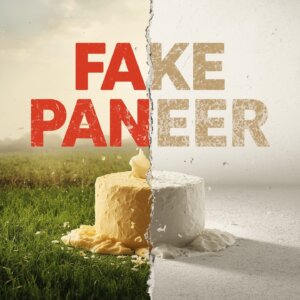Table of Contents
Introduction: A Hidden Health Risk in Your Plate?
Wondering how to identify fake paneer in your diet? Paneer has long been a staple in Indian kitchens — from festive dishes to everyday meals and high-protein diets. Celebrated for its rich protein content, calcium, and healthy fats, paneer is often considered the perfect vegetarian superfood.
However, paneer is becoming more vulnerable to adulteration due to increased demand. Across India, reports are growing of fake paneer made using synthetic milk, starch, detergent, and other harmful substances.
This blog discusses the growing problem of contaminated paneer in India, its dangers, and — above all — how to spot authentic paneer at home.
While paneer is often considered an excellent source of vegetarian protein, it’s important to compare it with other protein-rich options like eggs.
Why Paneer Is Considered a Superfood
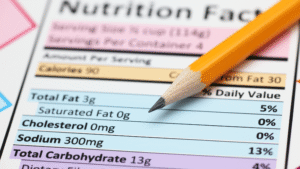
Nutritional Benefits of Real Paneer (Per 100g)
-
- Protein: 18–21g
-
- Calcium: ~200m- g
-
- Vitamin B12: Essential for vegetarians
-
- Low carbohydrate: ~1.2g
-
- Conjugated Linoleic Acid (CLA): Supports metabolism and fat loss
Nutritionist Rujuta Diwekar, in her book Indian Superfoods, emphasizes paneer as a “local treasure” that’s far more beneficial than imported supplements or processed protein sources.
Authentic paneer is a great source of calcium—one of the top contributors to bone strength as mentioned in our blog on calcium-rich foods.
The Rising Threat of Fake Paneer in India
What Is Fake Paneer?
Fake or synthetic paneer is often made using artificial ingredients rather than real milk. These may include:
Detergents, shampoo, and urea mixed with water (used in synthetic milk)
Starch for thickness
Washing powder or whiteners
Inedible oils and emulsifiers to mimic fat content
Why Is It So Widespread?
High demand in gyms, hotels, hostels, and households
Cheaper production costs for vendors
Low consumer awareness
Weak enforcement in small markets
An article in The Hindu from 2025 stated that the Food Safety and Standards Authority of India (FSSAI) tested 163 paneer samples from all throughout Karnataka and found that a significant amount of them were contaminated with harmful substances.
Health Risks of Consuming Synthetic Paneer

Long-term consumption of fake paneer can lead to:
Liver and kidney dysfunction (due to urea and detergents)
Digestive issues, bloating, and nausea
Hormonal disturbances
Increased cancer risk from chemical exposure
Weakened immune system and fatigue
A 2024 clinical study on food adulteration noted significant inflammatory responses in individuals consuming low-quality dairy products regularly.
Consuming adulterated paneer can cause bloating or indigestion—consider balancing your meal with foods that support digestion.
How to Identify Fake Paneer at Home: 5 Reliable & Real Tests
Knowing how to test paneer can protect your health. Try these quick, at-home methods:
1. Boiling Test
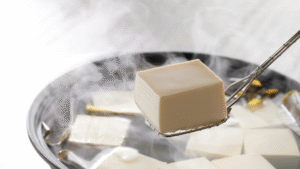
How to do it: Boil a small piece of paneer in water for 5–7 minutes.
-
- Real paneer: Remains soft and intact
-
- Fake paneer may begin to crumble, become sticky, or become rubbery.
2. Iodine (Starch) Test
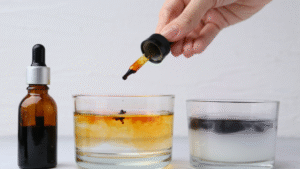
How to do it: Cool the boiled paneer, then add a few drops of iodine.
-
- Real paneer: No color change
-
- Fake paneer: Turns blue-black, indicating starch presence
(Based on common home food testing methods shared by FSSAI-approved resources)
- Fake paneer: Turns blue-black, indicating starch presence
3. Texture Test (Rub Test)
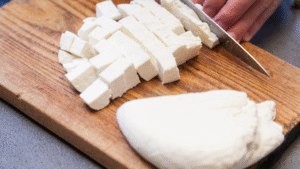
Rub a small piece between your fingers:
-
- Real: Slightly grainy or fibrous texture
-
- Fake: Waxy, unnaturally smooth, or rubbery
4. Smell Test

-
- Real paneer: Smells like fresh milk
-
- Fake paneer: May have a sour, chemical, or soapy odor
5. Controlled Burn Test (Optional & Safe-Environment Only)
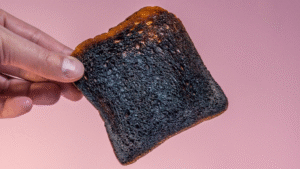
Burn a small sample safely.
-
- Real: Burns with a mild organic smell
-
- Fake: Emits a plastic-like odor, indicating chemical presence
How to Avoid Fake Paneer: Best Practices
1. Buy from Certified Brands
Look for FSSAI certification, expiry dates, and packaging details. Avoid loose paneer unless you trust the local dairy.
2. Watch the Shelf Life
Real paneer spoils within 2–3 days under refrigeration. If a packet claims a longer shelf life without freezing, it may contain preservatives or non-milk ingredients.
(As noted in food safety publications such as PubMed’s research on dairy shelf life)
3. Make Your Own Paneer
Homemade paneer is:-
-
- 100% pure and safe
-
- Easy to prepare
-
- Cost-effective
Easy Recipe:
-
- 1 liter of full-fat milk should be heated.
-
- Add one or two teaspoons of vinegar or lemon juice to get it to curdle.
-
- Strain the curds with a muslin cloth
-
- Press, refrigerate, and use within 2 days
4. Support Trusted Organic or A2 Brands
Several Indian startups now offer clean-label paneer, such as:
-
- Akshayakalpa
-
- Two Brothers Organic Farms
-
- Sid’s Farm
These brands focus on quality, traceability, and organic production.
Real vs Fake Paneer: At a Glance
| Feature | Real Paneer | Fake Paneer |
|---|---|---|
| Source | Cow or buffalo milk | Synthetic milk, starch |
| Texture | Soft, grainy | Waxy, rubbery |
| Shelf life | 2–3 days (fresh) | Unnaturally long |
| Smell | Dairy-like | Chemical or detergent-like |
| Health impact | Nutritious, protein-rich | Toxic, harmful |
Final Words: Choose Awareness Over Assumption
Paneer can either strengthen your body — or slowly weaken it, depending on its quality. In today’s food landscape, knowing how to identify real paneer is no longer optional — it’s essential.
If you care about your health, don’t just ask “what to eat” — ask:
“Is it real, or is it fake?”
References
FSSAI Paneer Sample Report – The Hindu, March 2025
https://www.thehindu.com/food/163-paneer-samples-tested-by-fssai-in-karnataka
Maximizing Shelf Life of Paneer – PubMed Review, 2016
https://pubmed.ncbi.nlm.nih.gov/
Rujuta Diwekar – Indian Superfoods, HarperCollins India

🎯 10+ years of Experience
🎓 10k+ Trained ( 📍 Jaipur )
💪 Helping change people’s lives
🌿 Most trusted lifestyle counselor

